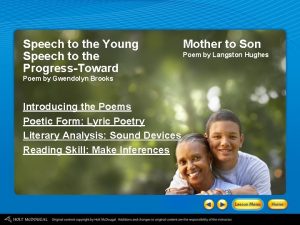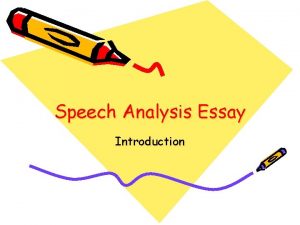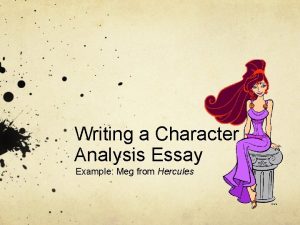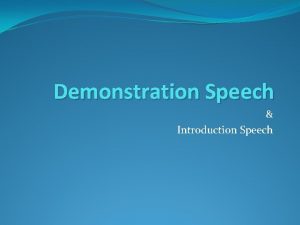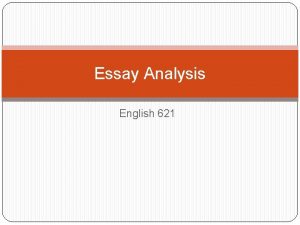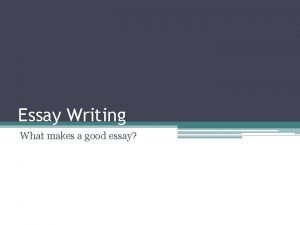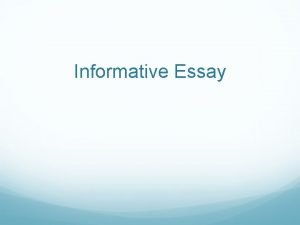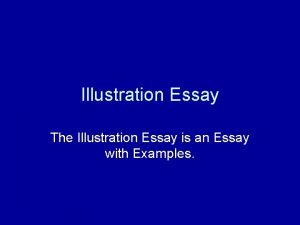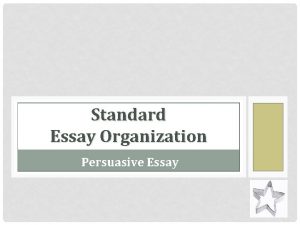Speech Analysis Essay Introduction What is the purpose

















- Slides: 17

Speech Analysis Essay Introduction

What is the purpose of the “speech analysis essay” or rhetorical analysis? • To identify the purpose and/or significance of a major speech from a work of literature and to show the literary/rhetorical devices develop this purpose.

What is the structure of a speech analysis essay? • Paragraph 1 – Introduction - Introduce title of the play and the playwright. Introduce the speech (where it occurs in the play and who is speaking). Provide a brief summary of the plot leading up to this speech. State the purpose and/or significance of this speech as your thesis statement. • Paragraph 2 – 4 – Body – Develop how the literary/rhetorical devices in the speech bring out the purpose of the speech. • Paragraph 5 - Conclusion – Reflect on significance of this speech to the plot, character development, and/or themes presented in the play as a whole.

What are some literary/rhetorical devices to look for in a Shakespearean speech? • • Diction (vocabulary, word usage, language) Syntax (sentence structure) Imagery (sensory details, particularly recurring images) Irony (verbal, situational, dramatic) Antithesis (oppositions) Paradox (contradictions) Repetition Figurative Language (simile, metaphor, personification, symbolism) • Sound Effects (alliteration, rhyme scheme, meter)

What are the specific requirements for this essay? • • • • Must be at least five paragraphs Must have a clear and strong thesis statement developed throughout the essay Must have at least one quotation or specific references from the play in each body paragraph Must have strong transitions between paragraphs, points, sentences Must set up all quotations and integrate quotations elegantly into the body of the text Must contain at least 8 sentences of commentary in each body paragraph (lots of Aha moments!!!) Must provide clear topic sentences at the beginning of each body paragraphs Must document all quotations with Act, scene, lines from the play Must include at least 3 different, distinct but prevalent literary/rhetorical terms to analyze the purpose of the speech Must have a good, original title Must have consistent verb tense in active voice Must be written in third person for an academic audience Must be very well-proofread for spelling, punctuation, grammar, sentence structure Must be typed in MLA format UNDERLINE THE TITLE OF THE PLAY!!!

Outline of Essay • Paragraph 1 – Introduction (title of play; playwright; location of speech; speaker, synopsis; purpose of speech = thesis) • Paragraphs 2 – 4 Body Paragraphs – Transition; topic sentence = literary element that brings out purpose; quote or specific references from play; commentary as to how examples illustrates the literary element presented that develops the purpose of the speech • Paragraph 5 – Conclusion – Significance

Commentary vs. Plot Summary – What’s the difference anyway? ? ? • Plot Summary – telling what the story is about or simply paraphrasing the quote

Commentary • Commentary – critically commenting on how the words, images, phrases from the text resonate with meaning and illustrate the point of the paragraph that develops thesis of the paper – Aha moments informed BY THE LANGUAGE IN THE TEXT!

Sample Plot Summary vs. Commentary (What is happening vs. analyzing the language) • From Macbeth: “Is this a dagger which I see before me” (II. i. 44) • Plot Summary - Macbeth is hallucinating and contemplating whether or not he sees a dagger. He is losing his senses. • Commentary – Using strong diction, such as the word ‘dagger’ underscores the intensity of Macbeth’s indecision and emotional disturbance.

Sample Plot Summary vs. Commentary • From Hamlet: • “O that this too sullied flesh would melt” (I. ii. 133) • Plot Summary – Hamlet seems to be contemplating suicide and wants his flesh to die. • Commentary – The repetition of ‘too’ emphasizes the extent to which Hamlet feels soiled by the political corruption that surrounds him.

A Word on Plagiarism • Don’t!!! • If you happen to consult outside sources, you MUST include a Works Cited page at the end, and DO NOT LIFT WORDS. Spark notes is only valuable for plot summary anyway, so it is really not helpful for analysis. • There are many thousands and thousands of academic resources that are much more valuable than Sparknotes. • Need to learn to recognize scholarship • SEE SAMPLE INTEGRATION OF RESEARCH

Sample Introduction Playwright, William Shakespeare, in his tragedy Macbeth, momentarily ceases the action through a soliloquy at a pivotal moment when the tragic hero, Macbeth reveals his deep reservations regarding the assassination of the King, Duncan. This speech occurs ironically after Lady Macbeth has bolstered Macbeth’s motivation for power but right before the bloody deed is actually scheduled to take place. Shakespeare’s includes this speech to show Macbeth’s deep indecision regarding he and his wife’s plan to murder the king to usurp the crown. (thesis = purpose of the speech)

Writing Process • Read the speech through several times within the context of the play as a whole. • Paraphrase the speech in your own words. • Underline, highlight, annotate striking examples of stylistic devices that convey the purpose. • Brainstorm your ideas and compose a rough draft.

Brainstorming Activity Stylistic Device Purpose of Speech Stylistic Device

Transitions • also, in the same way, just as. . . so too, likewise, similarly, but, however, in spite of, on the one hand. . . on the other hand, nevertheless, nonetheless, notwithstanding, in contrast, on the contrary, still, yet, first, second, third, . . . next, then, finally, afterward, at last, before, currently, during, earlier, immediately, later, meanwhile, now, recently, simultaneously, subsequently, then, for example, for instance, namely, specifically, to illustrate, even, indeed, in fact, of course, truly, accordingly, consequently, hence, so, therefore, thus, additionally, again, also, and, as well, besides, equally important, furthermore, in addition, moreover, then, finally, in a word, in brief, briefly, in conclusion, in the end, in the final analysis, on the whole, thus, to conclude, to summarize, in sum, to sum up, in summary

Integrating Quotations • 1. Make sure to set up all quotations by providing the context of the quote and who is speaking. • 2. Document the quotes with Act, scene, lines. • 3. Integrate the quotations or references from the speech into the body of your text. • SEE EXAMPLES OF COMMENTARY.

Sample Introduction Hamlet Playwright, William Shakespeare, in his tragedy Hamlet, ceases the action through a soliloquy in Act III, scene i at a pivotal moment when the tragic hero, Hamlet contemplates the advantages and disadvantages of human existence. This speech occurs after Polonius and Claudius further alienate Hamlet by using Ophelia as a ploy to spy on Hamlet’s antic behavior. Grief-stricken over his ill-fated circumstances , Hamlet attempts to reason out whether the unknown beyond death is any easier to bear than life. Shakespeare includes this soliloquy to illustrate Hamlet’s internal argument over the consequences of action or inaction.
 Speech to the young analysis
Speech to the young analysis Speech to the progress toward
Speech to the progress toward Body paragraph
Body paragraph Speech analysis introduction example
Speech analysis introduction example Meg character traits
Meg character traits Hát kết hợp bộ gõ cơ thể
Hát kết hợp bộ gõ cơ thể Slidetodoc
Slidetodoc Bổ thể
Bổ thể Tỉ lệ cơ thể trẻ em
Tỉ lệ cơ thể trẻ em Gấu đi như thế nào
Gấu đi như thế nào Chụp tư thế worms-breton
Chụp tư thế worms-breton Chúa sống lại
Chúa sống lại Môn thể thao bắt đầu bằng chữ f
Môn thể thao bắt đầu bằng chữ f Thế nào là hệ số cao nhất
Thế nào là hệ số cao nhất Các châu lục và đại dương trên thế giới
Các châu lục và đại dương trên thế giới Công của trọng lực
Công của trọng lực Trời xanh đây là của chúng ta thể thơ
Trời xanh đây là của chúng ta thể thơ Mật thư tọa độ 5x5
Mật thư tọa độ 5x5
